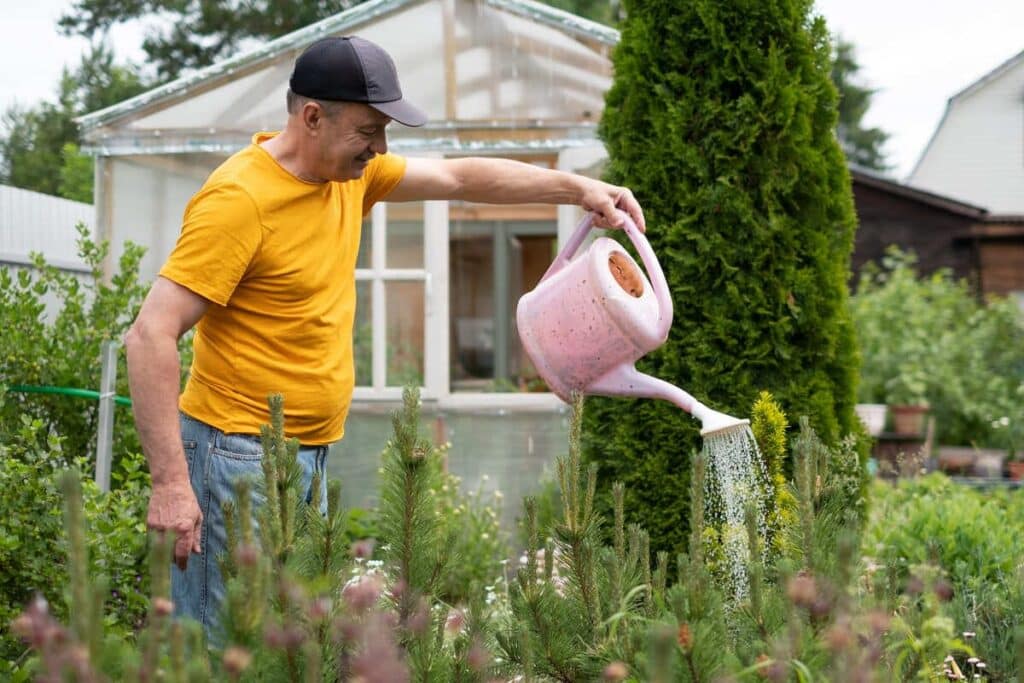Location
9669 Forest Lane Dallas,
TX 75243 USA
(214) 815-8728
Location
9669 Forest Lane Dallas,
TX 75243 USA
(214) 815-8728

Arborvitae is a genus of coniferous trees or shrubs in the Cupressaceae (cypress family). This elegant native evergreen is a natural choice for privacy that will allow you to use 7 backyard arborvitae landscaping ideas. Learn about the 7 best arborvitae types to plant in your backyard.

The most significant dwarf types are globe-shaped evergreens, ideal for green foliage in a garden bed.
Between the fifteen different arborvitae types, we can mention 5 of them:
Its foliage is a golden yellow color and can grow 1.5 to 2 feet tall.

It remains in globe form with little priming. It stays green all year and will stand no more than two feet tall and less than three feet wide at maturity.
The Danica only reaches 2 feet high when fully mature. It thrives in containers. Its foliage is emerald green.
The foliage of the whipcord arborvitae hangs, showing its long narrow leaves whose color varies from emerald green to yellow-green.
While it can grow up to four feet high, it’s often used as ground cover.
Emerald Green lives up to its name—a rich color in a cylindrical shape. With heights reaching 15 feet, it’s more of a medium-height tree than a true dwarf. It’s great for small properties, but it isn’t deer resistant.

These 4 types of 15 most significant evergreens can grow to incredible heights. They are trees you want in your landscape.
The North Pole is a hedge plant with a narrow shape. Their tight columnar growth makes them the ideal privacy plants for limited sites.
It is also known as the Northern White Cedar, although it isn’t related to the cedar genus. It will reach up to 40 feet tall and 20 feet wide at maturity. Its foliage maintains a dark green color.
It’s very similar to the Emerald Green arborvitae. Its foliage is a matching deep green but more tapered at the top. It grows faster and can reach a height of 30 feet.
If left unchecked, the thuja green giant arborvitae will grow 30 to 60 feet tall and 12 feet wide.

Western red cedar is part of the same plant family of cedar (Cupressaceae). It can live 1,000 years old with a dark green foliage color.
It is an important commercial timber tree in Japan, and as exciting data, it is not an ornamental tree in Japan; in contrast, it is one of the five sacred trees of Kiso, a productive forest in that country. Its foliage color is gray-green.
This tree perfectly lives in Korea and China and rarely uses gardening because it lacks large seed stock. It has a Straight green on top and a whitish on the bottom foliage color.
Sichuan thuja was extinct but rediscovered in their province Sichuan. Its foliage color is deep, vibrant green.
This yellow-green to golden color tree typically accents landscapes making it a garden favorite because of its interestingly-colored, year-round foliage.
Unlike other varieties, Holmstrom grows very slowly and is a trim specie suiting; this green with a slight golden hue tree is the perfect candidate for smaller areas.
Smaragd is also known as the emerald green arborvitae because its name.

Arborvitae is a valuable and vital tree to the native Americans for building canoes, hunting equipment, basketry, clothing, coffins, spiritual ceremonies, and much more. It is also known as the “Tree of Life” because of its benefits.
These trees are an excellent option for privacy screens, landscaping accents, and windbreaks.
Arborvitae will provide you with different looks and uses; learn about it:

The barriers are the most popular use of the arborvitae. They create a green wall of dense foliage that separates areas in your backyard, making an ideal privacy space. They overgrow and ease of care.
A windbreak is a row of trees planted perpendicular to the prevailing winds on the windward side of a crop or structure.
The created wall reduces wind damage in zones like California.
Arborvitae also works well as stand-alone plants; taller varieties can work as a garden’s centerpiece. At the same time, smaller varieties are excellent sculptural additions and accents. A spot in any garden usually looks nice with some arborvitae.

Arborvitae doesn’t just work as a privacy screen; it is a corridor that will send you on an imaginative trip, providing a beautiful way to invite people in.
Arborvitae fits perfectly around your backyard. Use a series of these trees alongside the walkway to the back of the home. Or put one on each side of your doorway.
Or do both. The possibilities for landscaping with arborvitae are endless.

Tree of Life works well alone or with other trees, flowers, and perennial plants.
Because of its impressive look, it can make great focal points in your backyard.
The dwarf and tall varieties are great options; you can mix the most popular types.
In addition, the ‘Green Giant,’ as an evergreen, also keeps its gorgeous dark green shade and glossy sheen all year.

This type of tree or shrub is an excellent candidate to sculpt unique decorative touch to your backyard, reflecting your style and personality. For that reason, hiring Rudy´s professionals to create exclusive looks and provide an extra-polish feeling in your back home is essential.
If you read until here, you are ready to plant any beautiful arborvitae that captured your attention.
Incorporate these backyard arborvitae landscaping ideas; provided in this blog post, and enjoy your magnificent green yard.
